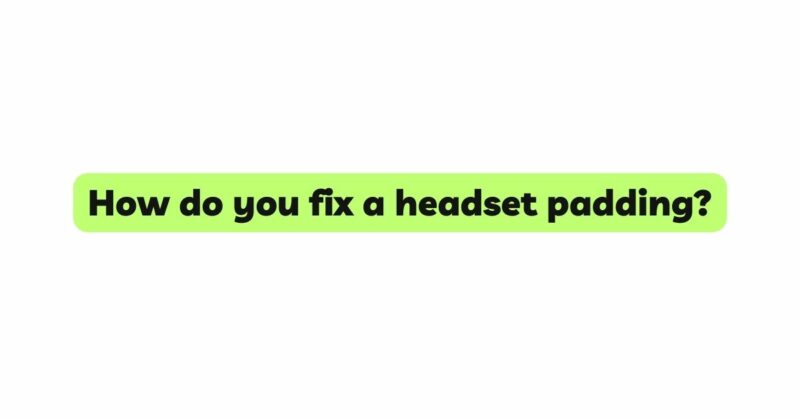Headsets are essential tools for communication, gaming, and audio enjoyment. Over time, the padding on the ear cups and headband can wear out, leading to discomfort and compromised sound quality. Fortunately, there are several methods to fix headset padding and restore it to its original comfort and functionality. In this article, we provide a step-by-step guide on how to fix headset padding, covering various DIY solutions for different padding materials and wear conditions.
- Assess the Damage:
Before attempting any fixes, carefully examine the condition of the headset padding. Look for signs of wear, tears, peeling, or flattened foam. Take note of the padding material, whether it is leather, synthetic leather, velour, or foam, as different materials may require different repair approaches.
- Cleaning the Padding:
Start by cleaning the padding to remove any dirt, oils, and debris that may have accumulated over time. Use a soft cloth or a cotton ball dampened with a mild soap and water solution to gently clean the surface of the padding. Avoid using harsh chemicals, as they can further damage the padding material.
- Fixing Peeling or Cracked Leather/Synthetic Leather Padding:
For peeling or cracked leather or synthetic leather padding, consider using a leather repair kit. These kits typically come with adhesive and color-matching compounds. Follow these steps to fix the padding:
a. Gently clean the peeling area with a damp cloth to remove any dirt or oils.
b. Apply a small amount of leather or synthetic leather adhesive to the backside of the peeling portion.
c. Press the peeling part back into place and hold it firmly until the adhesive sets. Use a clamp or binder clip if necessary.
d. If there are gaps or cracks, use the color-matching compound from the repair kit to fill them in, following the kit’s instructions.
- Repairing Flattened Foam Padding:
Foam padding can lose its resilience over time, resulting in flattened and uncomfortable cushions. To restore the padding, you can try the following methods:
a. Memory Foam Recovery: If the headset has memory foam padding, gently knead and manipulate the foam with your hands to restore its original shape. Allow it to sit and expand naturally for a few hours.
b. Adding Foam Inserts: If the foam has permanently lost its shape, consider inserting additional foam layers or cushions within the existing padding. This can help restore the cushion’s loft and comfort.
- Repairing Velour or Cloth Padding:
Velour and cloth padding may become flattened or frayed over time. To fix these issues, try the following methods:
a. Fluffing Velour Padding: Gently brush the velour padding with a soft-bristled brush to revive the fibers and restore the cushion’s fluffiness.
b. Replacing Cloth Padding: If the cloth padding is severely worn or frayed, consider replacing it entirely with new cloth or foam inserts.
- Reinforcing Headband Padding:
Headband padding can also wear out, leading to discomfort during extended use. To reinforce the headband padding, you can use the following method:
a. Adding Cushioning: Attach additional foam or memory foam pads to the headband using adhesive or Velcro strips. This provides extra cushioning and comfort for the top of your head.
- DIY Replacement Ear Pads:
If your headset’s ear pads are beyond repair or unavailable for purchase, consider making DIY replacement pads. Here’s a simple method:
a. Cut Out New Pads: Trace the shape of the original ear pads onto a piece of foam or memory foam. Cut out the new pads following the traced lines.
b. Attach the New Pads: Use adhesive or Velcro strips to attach the new pads to the ear cups.
- Purchasing Replacement Pads:
If your headset is from a well-known brand, check if they offer replacement pads for purchase. Many manufacturers sell replacement pads specifically designed for their headsets.
Conclusion:
Fixing headset padding is an essential skill for extending the life and comfort of your headphones. Assess the condition of the padding and choose the appropriate repair method based on the padding material and damage severity. By properly maintaining and repairing headset padding, you can continue to enjoy a comfortable and optimal listening experience for many years. Whether it’s fixing peeling leather, restoring flattened foam, repairing velour or cloth padding, reinforcing the headband, or making DIY replacement ear pads, there are several effective approaches to bring new life to your headset’s cushions.


